Analysis of the Development, Use, and Ethics of Nuclear Weapons
VerifiedAdded on 2023/06/10
|6
|1831
|350
Essay
AI Summary
This essay examines the ethical problems associated with the existence and use of nuclear weapons, particularly in the 21st century. It discusses the role of nuclear weapons in international security, their impact on military planning, and the moral implications of their destructive capabilities. The essay delves into nuclear ethics, considering the potential for infanticide, massacre, and the overall threat to human life and the planet. It also explores how advancements in conventional weapons technology may reduce the reliance on nuclear weapons, while emphasizing the importance of intelligence and accuracy in target demolition. The paper concludes by addressing the proliferation of weapons technology, the potential for state-to-state defense, and the need for a balanced approach to maintaining nuclear forces in a changing geopolitical environment. Desklib provides resources for students to further explore topics in political science and international relations.
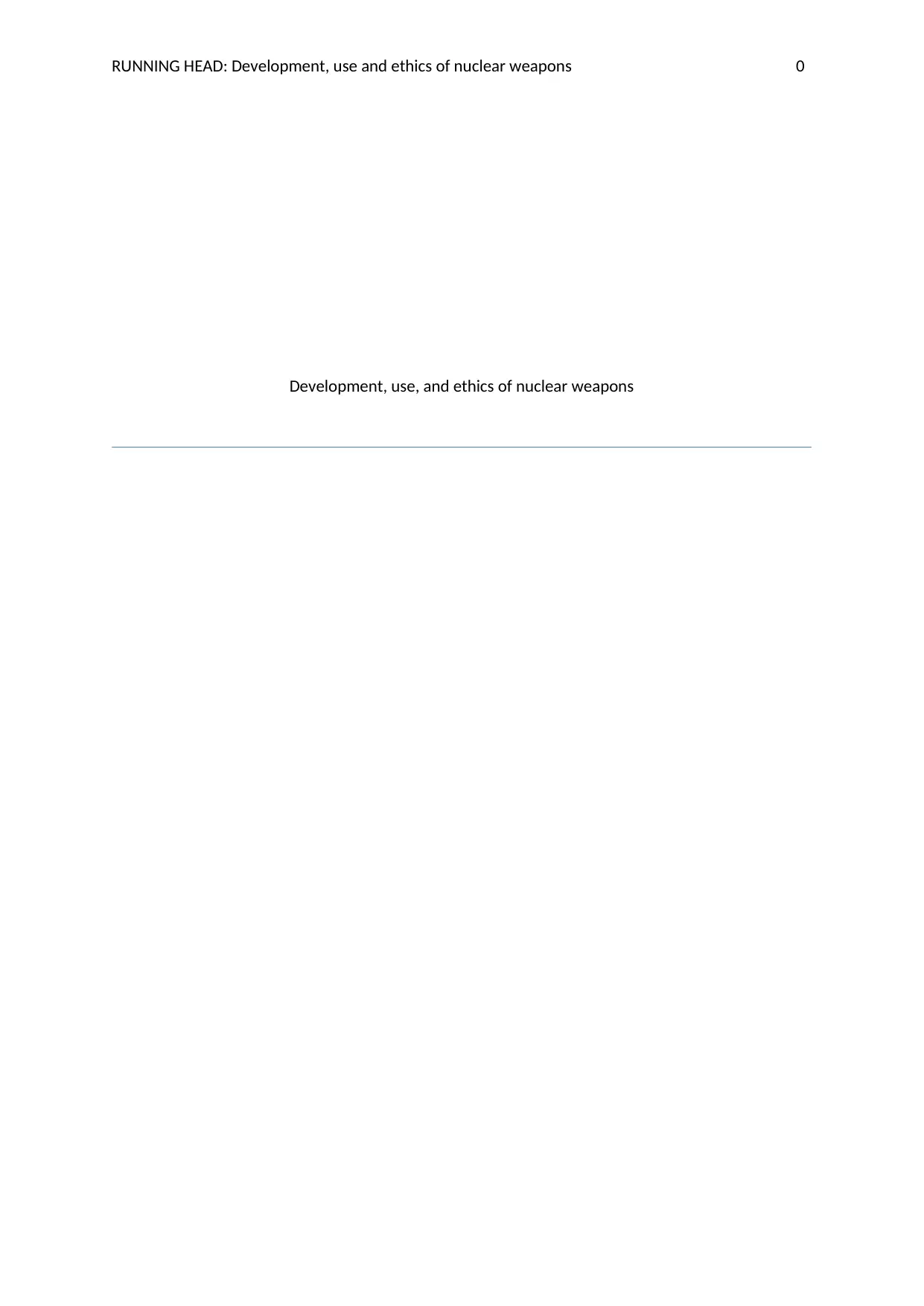
RUNNING HEAD: Development, use and ethics of nuclear weapons 0
Development, use, and ethics of nuclear weapons
Development, use, and ethics of nuclear weapons
Paraphrase This Document
Need a fresh take? Get an instant paraphrase of this document with our AI Paraphraser
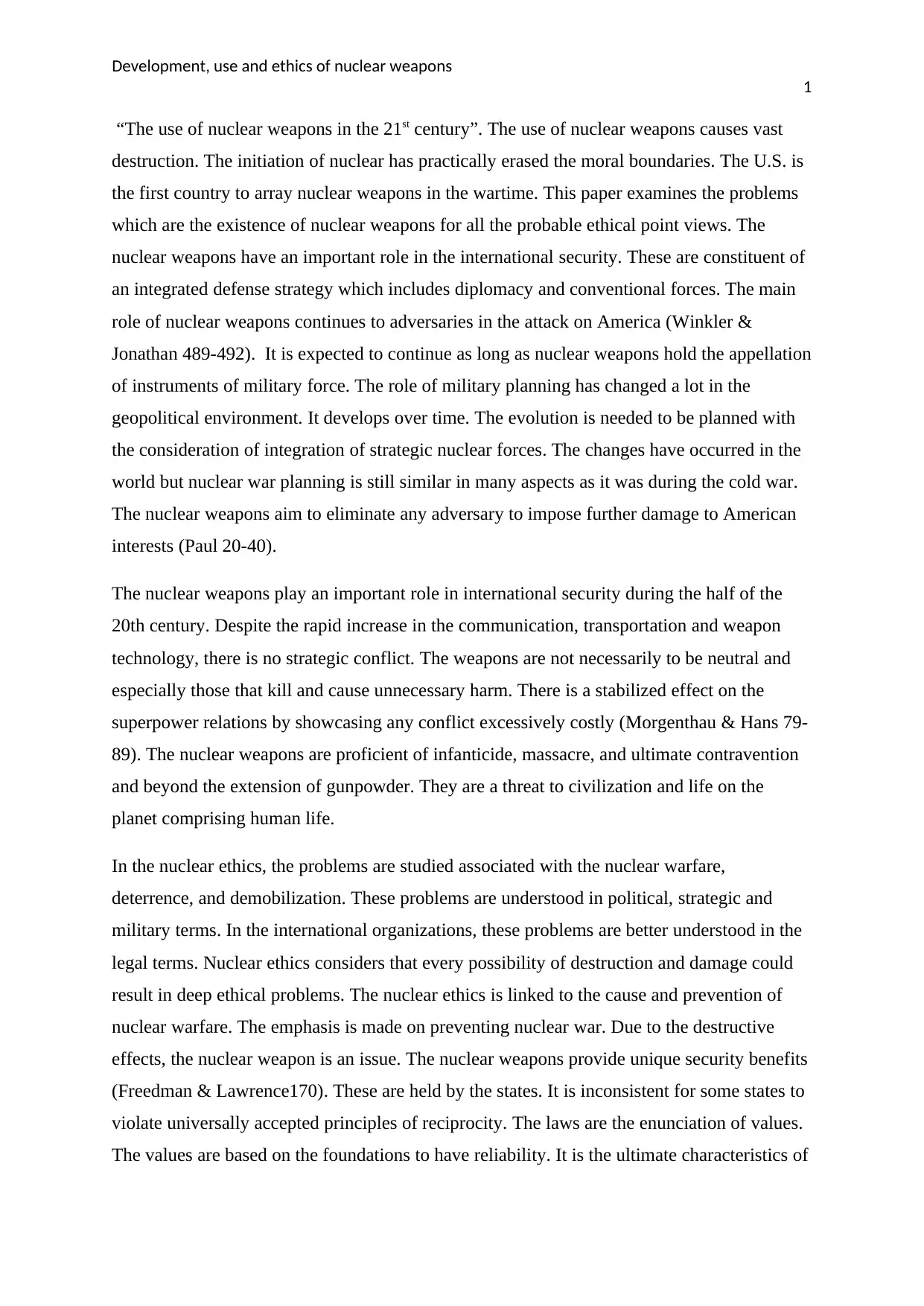
Development, use and ethics of nuclear weapons
1
“The use of nuclear weapons in the 21st century”. The use of nuclear weapons causes vast
destruction. The initiation of nuclear has practically erased the moral boundaries. The U.S. is
the first country to array nuclear weapons in the wartime. This paper examines the problems
which are the existence of nuclear weapons for all the probable ethical point views. The
nuclear weapons have an important role in the international security. These are constituent of
an integrated defense strategy which includes diplomacy and conventional forces. The main
role of nuclear weapons continues to adversaries in the attack on America (Winkler &
Jonathan 489-492). It is expected to continue as long as nuclear weapons hold the appellation
of instruments of military force. The role of military planning has changed a lot in the
geopolitical environment. It develops over time. The evolution is needed to be planned with
the consideration of integration of strategic nuclear forces. The changes have occurred in the
world but nuclear war planning is still similar in many aspects as it was during the cold war.
The nuclear weapons aim to eliminate any adversary to impose further damage to American
interests (Paul 20-40).
The nuclear weapons play an important role in international security during the half of the
20th century. Despite the rapid increase in the communication, transportation and weapon
technology, there is no strategic conflict. The weapons are not necessarily to be neutral and
especially those that kill and cause unnecessary harm. There is a stabilized effect on the
superpower relations by showcasing any conflict excessively costly (Morgenthau & Hans 79-
89). The nuclear weapons are proficient of infanticide, massacre, and ultimate contravention
and beyond the extension of gunpowder. They are a threat to civilization and life on the
planet comprising human life.
In the nuclear ethics, the problems are studied associated with the nuclear warfare,
deterrence, and demobilization. These problems are understood in political, strategic and
military terms. In the international organizations, these problems are better understood in the
legal terms. Nuclear ethics considers that every possibility of destruction and damage could
result in deep ethical problems. The nuclear ethics is linked to the cause and prevention of
nuclear warfare. The emphasis is made on preventing nuclear war. Due to the destructive
effects, the nuclear weapon is an issue. The nuclear weapons provide unique security benefits
(Freedman & Lawrence170). These are held by the states. It is inconsistent for some states to
violate universally accepted principles of reciprocity. The laws are the enunciation of values.
The values are based on the foundations to have reliability. It is the ultimate characteristics of
1
“The use of nuclear weapons in the 21st century”. The use of nuclear weapons causes vast
destruction. The initiation of nuclear has practically erased the moral boundaries. The U.S. is
the first country to array nuclear weapons in the wartime. This paper examines the problems
which are the existence of nuclear weapons for all the probable ethical point views. The
nuclear weapons have an important role in the international security. These are constituent of
an integrated defense strategy which includes diplomacy and conventional forces. The main
role of nuclear weapons continues to adversaries in the attack on America (Winkler &
Jonathan 489-492). It is expected to continue as long as nuclear weapons hold the appellation
of instruments of military force. The role of military planning has changed a lot in the
geopolitical environment. It develops over time. The evolution is needed to be planned with
the consideration of integration of strategic nuclear forces. The changes have occurred in the
world but nuclear war planning is still similar in many aspects as it was during the cold war.
The nuclear weapons aim to eliminate any adversary to impose further damage to American
interests (Paul 20-40).
The nuclear weapons play an important role in international security during the half of the
20th century. Despite the rapid increase in the communication, transportation and weapon
technology, there is no strategic conflict. The weapons are not necessarily to be neutral and
especially those that kill and cause unnecessary harm. There is a stabilized effect on the
superpower relations by showcasing any conflict excessively costly (Morgenthau & Hans 79-
89). The nuclear weapons are proficient of infanticide, massacre, and ultimate contravention
and beyond the extension of gunpowder. They are a threat to civilization and life on the
planet comprising human life.
In the nuclear ethics, the problems are studied associated with the nuclear warfare,
deterrence, and demobilization. These problems are understood in political, strategic and
military terms. In the international organizations, these problems are better understood in the
legal terms. Nuclear ethics considers that every possibility of destruction and damage could
result in deep ethical problems. The nuclear ethics is linked to the cause and prevention of
nuclear warfare. The emphasis is made on preventing nuclear war. Due to the destructive
effects, the nuclear weapon is an issue. The nuclear weapons provide unique security benefits
(Freedman & Lawrence170). These are held by the states. It is inconsistent for some states to
violate universally accepted principles of reciprocity. The laws are the enunciation of values.
The values are based on the foundations to have reliability. It is the ultimate characteristics of
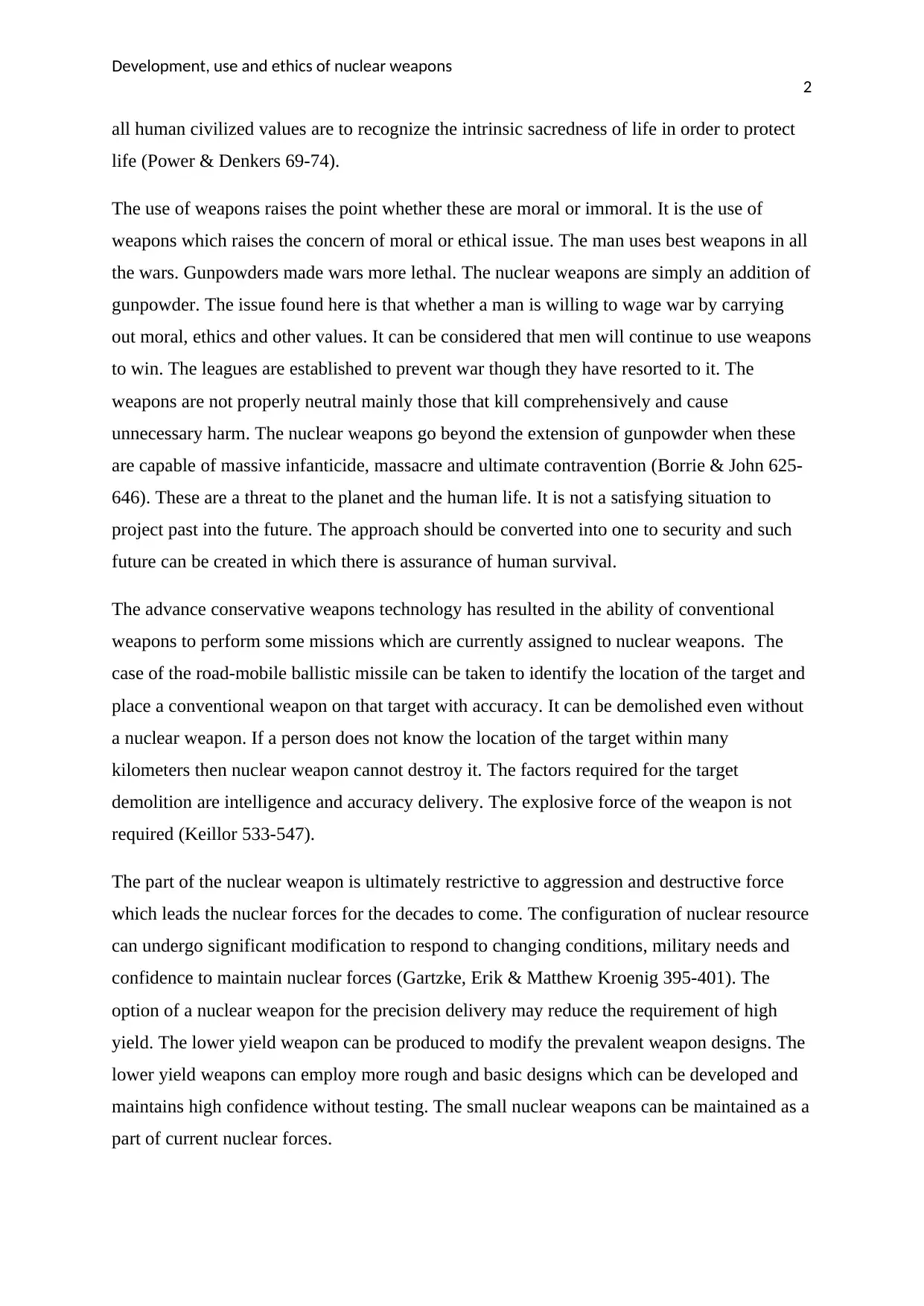
Development, use and ethics of nuclear weapons
2
all human civilized values are to recognize the intrinsic sacredness of life in order to protect
life (Power & Denkers 69-74).
The use of weapons raises the point whether these are moral or immoral. It is the use of
weapons which raises the concern of moral or ethical issue. The man uses best weapons in all
the wars. Gunpowders made wars more lethal. The nuclear weapons are simply an addition of
gunpowder. The issue found here is that whether a man is willing to wage war by carrying
out moral, ethics and other values. It can be considered that men will continue to use weapons
to win. The leagues are established to prevent war though they have resorted to it. The
weapons are not properly neutral mainly those that kill comprehensively and cause
unnecessary harm. The nuclear weapons go beyond the extension of gunpowder when these
are capable of massive infanticide, massacre and ultimate contravention (Borrie & John 625-
646). These are a threat to the planet and the human life. It is not a satisfying situation to
project past into the future. The approach should be converted into one to security and such
future can be created in which there is assurance of human survival.
The advance conservative weapons technology has resulted in the ability of conventional
weapons to perform some missions which are currently assigned to nuclear weapons. The
case of the road-mobile ballistic missile can be taken to identify the location of the target and
place a conventional weapon on that target with accuracy. It can be demolished even without
a nuclear weapon. If a person does not know the location of the target within many
kilometers then nuclear weapon cannot destroy it. The factors required for the target
demolition are intelligence and accuracy delivery. The explosive force of the weapon is not
required (Keillor 533-547).
The part of the nuclear weapon is ultimately restrictive to aggression and destructive force
which leads the nuclear forces for the decades to come. The configuration of nuclear resource
can undergo significant modification to respond to changing conditions, military needs and
confidence to maintain nuclear forces (Gartzke, Erik & Matthew Kroenig 395-401). The
option of a nuclear weapon for the precision delivery may reduce the requirement of high
yield. The lower yield weapon can be produced to modify the prevalent weapon designs. The
lower yield weapons can employ more rough and basic designs which can be developed and
maintains high confidence without testing. The small nuclear weapons can be maintained as a
part of current nuclear forces.
2
all human civilized values are to recognize the intrinsic sacredness of life in order to protect
life (Power & Denkers 69-74).
The use of weapons raises the point whether these are moral or immoral. It is the use of
weapons which raises the concern of moral or ethical issue. The man uses best weapons in all
the wars. Gunpowders made wars more lethal. The nuclear weapons are simply an addition of
gunpowder. The issue found here is that whether a man is willing to wage war by carrying
out moral, ethics and other values. It can be considered that men will continue to use weapons
to win. The leagues are established to prevent war though they have resorted to it. The
weapons are not properly neutral mainly those that kill comprehensively and cause
unnecessary harm. The nuclear weapons go beyond the extension of gunpowder when these
are capable of massive infanticide, massacre and ultimate contravention (Borrie & John 625-
646). These are a threat to the planet and the human life. It is not a satisfying situation to
project past into the future. The approach should be converted into one to security and such
future can be created in which there is assurance of human survival.
The advance conservative weapons technology has resulted in the ability of conventional
weapons to perform some missions which are currently assigned to nuclear weapons. The
case of the road-mobile ballistic missile can be taken to identify the location of the target and
place a conventional weapon on that target with accuracy. It can be demolished even without
a nuclear weapon. If a person does not know the location of the target within many
kilometers then nuclear weapon cannot destroy it. The factors required for the target
demolition are intelligence and accuracy delivery. The explosive force of the weapon is not
required (Keillor 533-547).
The part of the nuclear weapon is ultimately restrictive to aggression and destructive force
which leads the nuclear forces for the decades to come. The configuration of nuclear resource
can undergo significant modification to respond to changing conditions, military needs and
confidence to maintain nuclear forces (Gartzke, Erik & Matthew Kroenig 395-401). The
option of a nuclear weapon for the precision delivery may reduce the requirement of high
yield. The lower yield weapon can be produced to modify the prevalent weapon designs. The
lower yield weapons can employ more rough and basic designs which can be developed and
maintains high confidence without testing. The small nuclear weapons can be maintained as a
part of current nuclear forces.
⊘ This is a preview!⊘
Do you want full access?
Subscribe today to unlock all pages.

Trusted by 1+ million students worldwide
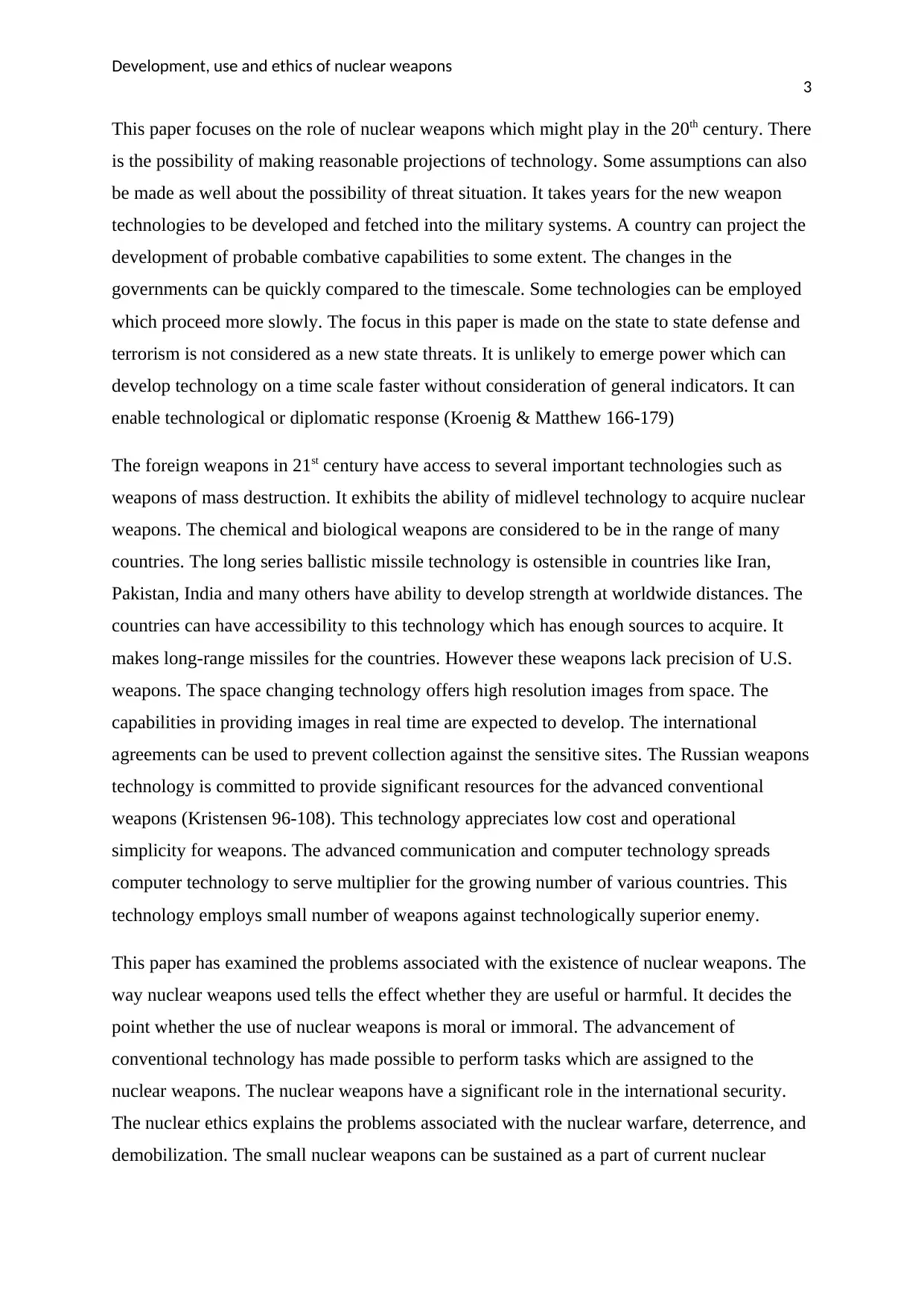
Development, use and ethics of nuclear weapons
3
This paper focuses on the role of nuclear weapons which might play in the 20th century. There
is the possibility of making reasonable projections of technology. Some assumptions can also
be made as well about the possibility of threat situation. It takes years for the new weapon
technologies to be developed and fetched into the military systems. A country can project the
development of probable combative capabilities to some extent. The changes in the
governments can be quickly compared to the timescale. Some technologies can be employed
which proceed more slowly. The focus in this paper is made on the state to state defense and
terrorism is not considered as a new state threats. It is unlikely to emerge power which can
develop technology on a time scale faster without consideration of general indicators. It can
enable technological or diplomatic response (Kroenig & Matthew 166-179)
The foreign weapons in 21st century have access to several important technologies such as
weapons of mass destruction. It exhibits the ability of midlevel technology to acquire nuclear
weapons. The chemical and biological weapons are considered to be in the range of many
countries. The long series ballistic missile technology is ostensible in countries like Iran,
Pakistan, India and many others have ability to develop strength at worldwide distances. The
countries can have accessibility to this technology which has enough sources to acquire. It
makes long-range missiles for the countries. However these weapons lack precision of U.S.
weapons. The space changing technology offers high resolution images from space. The
capabilities in providing images in real time are expected to develop. The international
agreements can be used to prevent collection against the sensitive sites. The Russian weapons
technology is committed to provide significant resources for the advanced conventional
weapons (Kristensen 96-108). This technology appreciates low cost and operational
simplicity for weapons. The advanced communication and computer technology spreads
computer technology to serve multiplier for the growing number of various countries. This
technology employs small number of weapons against technologically superior enemy.
This paper has examined the problems associated with the existence of nuclear weapons. The
way nuclear weapons used tells the effect whether they are useful or harmful. It decides the
point whether the use of nuclear weapons is moral or immoral. The advancement of
conventional technology has made possible to perform tasks which are assigned to the
nuclear weapons. The nuclear weapons have a significant role in the international security.
The nuclear ethics explains the problems associated with the nuclear warfare, deterrence, and
demobilization. The small nuclear weapons can be sustained as a part of current nuclear
3
This paper focuses on the role of nuclear weapons which might play in the 20th century. There
is the possibility of making reasonable projections of technology. Some assumptions can also
be made as well about the possibility of threat situation. It takes years for the new weapon
technologies to be developed and fetched into the military systems. A country can project the
development of probable combative capabilities to some extent. The changes in the
governments can be quickly compared to the timescale. Some technologies can be employed
which proceed more slowly. The focus in this paper is made on the state to state defense and
terrorism is not considered as a new state threats. It is unlikely to emerge power which can
develop technology on a time scale faster without consideration of general indicators. It can
enable technological or diplomatic response (Kroenig & Matthew 166-179)
The foreign weapons in 21st century have access to several important technologies such as
weapons of mass destruction. It exhibits the ability of midlevel technology to acquire nuclear
weapons. The chemical and biological weapons are considered to be in the range of many
countries. The long series ballistic missile technology is ostensible in countries like Iran,
Pakistan, India and many others have ability to develop strength at worldwide distances. The
countries can have accessibility to this technology which has enough sources to acquire. It
makes long-range missiles for the countries. However these weapons lack precision of U.S.
weapons. The space changing technology offers high resolution images from space. The
capabilities in providing images in real time are expected to develop. The international
agreements can be used to prevent collection against the sensitive sites. The Russian weapons
technology is committed to provide significant resources for the advanced conventional
weapons (Kristensen 96-108). This technology appreciates low cost and operational
simplicity for weapons. The advanced communication and computer technology spreads
computer technology to serve multiplier for the growing number of various countries. This
technology employs small number of weapons against technologically superior enemy.
This paper has examined the problems associated with the existence of nuclear weapons. The
way nuclear weapons used tells the effect whether they are useful or harmful. It decides the
point whether the use of nuclear weapons is moral or immoral. The advancement of
conventional technology has made possible to perform tasks which are assigned to the
nuclear weapons. The nuclear weapons have a significant role in the international security.
The nuclear ethics explains the problems associated with the nuclear warfare, deterrence, and
demobilization. The small nuclear weapons can be sustained as a part of current nuclear
Paraphrase This Document
Need a fresh take? Get an instant paraphrase of this document with our AI Paraphraser

Development, use and ethics of nuclear weapons
4
forces. The technology used in nuclear weapons engages a small number of weapons against
the technologically superior enemy.
4
forces. The technology used in nuclear weapons engages a small number of weapons against
the technologically superior enemy.
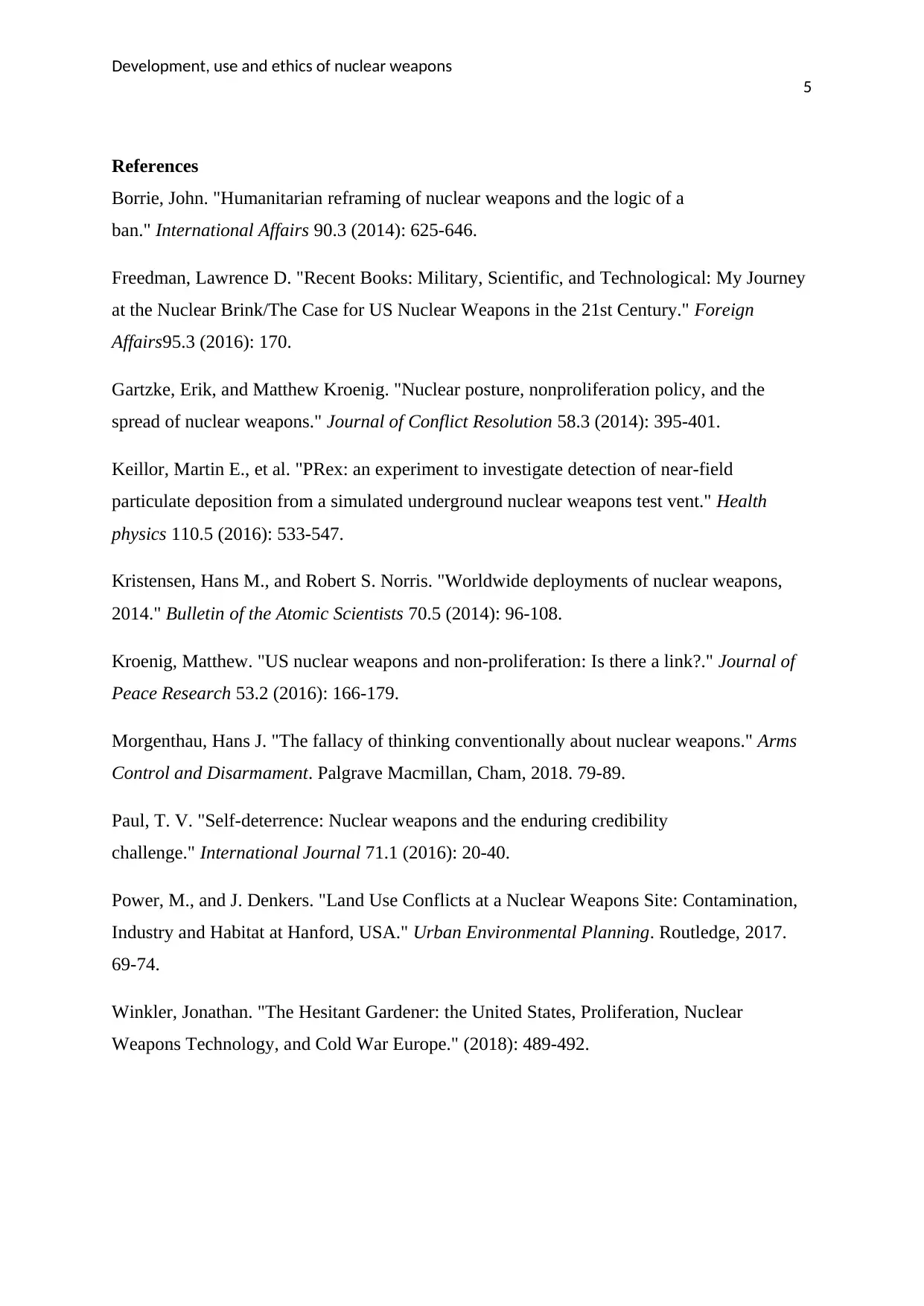
Development, use and ethics of nuclear weapons
5
References
Borrie, John. "Humanitarian reframing of nuclear weapons and the logic of a
ban." International Affairs 90.3 (2014): 625-646.
Freedman, Lawrence D. "Recent Books: Military, Scientific, and Technological: My Journey
at the Nuclear Brink/The Case for US Nuclear Weapons in the 21st Century." Foreign
Affairs95.3 (2016): 170.
Gartzke, Erik, and Matthew Kroenig. "Nuclear posture, nonproliferation policy, and the
spread of nuclear weapons." Journal of Conflict Resolution 58.3 (2014): 395-401.
Keillor, Martin E., et al. "PRex: an experiment to investigate detection of near-field
particulate deposition from a simulated underground nuclear weapons test vent." Health
physics 110.5 (2016): 533-547.
Kristensen, Hans M., and Robert S. Norris. "Worldwide deployments of nuclear weapons,
2014." Bulletin of the Atomic Scientists 70.5 (2014): 96-108.
Kroenig, Matthew. "US nuclear weapons and non-proliferation: Is there a link?." Journal of
Peace Research 53.2 (2016): 166-179.
Morgenthau, Hans J. "The fallacy of thinking conventionally about nuclear weapons." Arms
Control and Disarmament. Palgrave Macmillan, Cham, 2018. 79-89.
Paul, T. V. "Self-deterrence: Nuclear weapons and the enduring credibility
challenge." International Journal 71.1 (2016): 20-40.
Power, M., and J. Denkers. "Land Use Conflicts at a Nuclear Weapons Site: Contamination,
Industry and Habitat at Hanford, USA." Urban Environmental Planning. Routledge, 2017.
69-74.
Winkler, Jonathan. "The Hesitant Gardener: the United States, Proliferation, Nuclear
Weapons Technology, and Cold War Europe." (2018): 489-492.
5
References
Borrie, John. "Humanitarian reframing of nuclear weapons and the logic of a
ban." International Affairs 90.3 (2014): 625-646.
Freedman, Lawrence D. "Recent Books: Military, Scientific, and Technological: My Journey
at the Nuclear Brink/The Case for US Nuclear Weapons in the 21st Century." Foreign
Affairs95.3 (2016): 170.
Gartzke, Erik, and Matthew Kroenig. "Nuclear posture, nonproliferation policy, and the
spread of nuclear weapons." Journal of Conflict Resolution 58.3 (2014): 395-401.
Keillor, Martin E., et al. "PRex: an experiment to investigate detection of near-field
particulate deposition from a simulated underground nuclear weapons test vent." Health
physics 110.5 (2016): 533-547.
Kristensen, Hans M., and Robert S. Norris. "Worldwide deployments of nuclear weapons,
2014." Bulletin of the Atomic Scientists 70.5 (2014): 96-108.
Kroenig, Matthew. "US nuclear weapons and non-proliferation: Is there a link?." Journal of
Peace Research 53.2 (2016): 166-179.
Morgenthau, Hans J. "The fallacy of thinking conventionally about nuclear weapons." Arms
Control and Disarmament. Palgrave Macmillan, Cham, 2018. 79-89.
Paul, T. V. "Self-deterrence: Nuclear weapons and the enduring credibility
challenge." International Journal 71.1 (2016): 20-40.
Power, M., and J. Denkers. "Land Use Conflicts at a Nuclear Weapons Site: Contamination,
Industry and Habitat at Hanford, USA." Urban Environmental Planning. Routledge, 2017.
69-74.
Winkler, Jonathan. "The Hesitant Gardener: the United States, Proliferation, Nuclear
Weapons Technology, and Cold War Europe." (2018): 489-492.
⊘ This is a preview!⊘
Do you want full access?
Subscribe today to unlock all pages.

Trusted by 1+ million students worldwide
1 out of 6
Related Documents
Your All-in-One AI-Powered Toolkit for Academic Success.
+13062052269
info@desklib.com
Available 24*7 on WhatsApp / Email
![[object Object]](/_next/static/media/star-bottom.7253800d.svg)
Unlock your academic potential
Copyright © 2020–2025 A2Z Services. All Rights Reserved. Developed and managed by ZUCOL.





